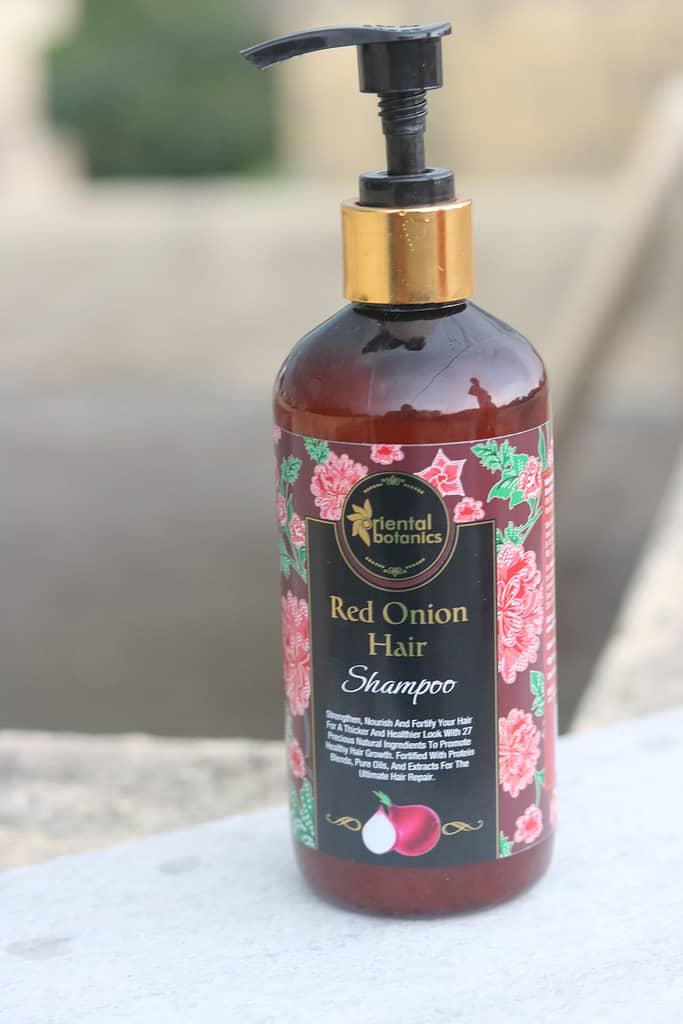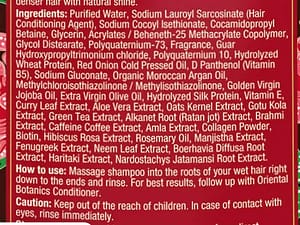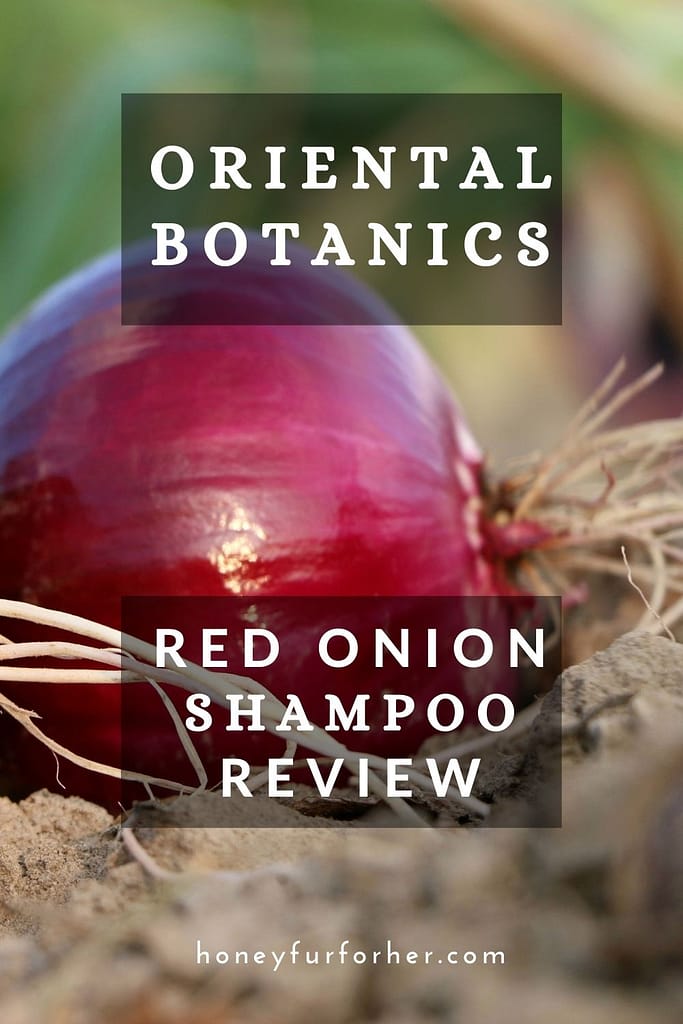
Product: Oriental Botanics red onion shampoo
Price: 300ml bottle for Rs 399 On Amazon Or Flipkart. The written MRP is Rs 699.
Directions of Use:
Message shampoo into the roots of your wet hair right down to the ends and rinse.
Ingredients:
Purified water
Sodium Lauroyl Sarcosinate
Sodium Cocoyl Isethionate
Cocamidopropyl Betaine
Glycerin
Acrylates / Beheneth-25 Methacrylate Copolymer
Glycol Distearate
Polyquaternium-73
Fragrance
Guar Hydroxypropyltrimonium Chloride
Polyquaternium 10
Hydrolyzed Wheat Protein
Red Onion Cold Pressed oil
D Panthenol (Vitamin B5)
Sodium Gluconate
Organic Morroccan Argan Oil
Methylchloroisothiazolinone / Methylisothiazolinone
Golden Virgin Jojoba Oil
Extra Vergin Olive Oil
Hydrolyzed Silk Protein
Vitamin E
Caffeine Coffee Extract
Green Tea Extract
Collagen Powder
Biotin
Oats Kernel Extract

Ayurvedic Ingredients
Curry Leaf Extract
Aloe Vera Extract
Gotu Kola Extract
Alkanet Root (Ratanjot) Extract
Brahmi Extract
Amla Extract
Hibiscus Rosa Extract
Rosemary Oil
Manijistha Extract
Fenugreek Extract
Neem Leaf Extract
Boerhavia Diffusa Root Extract
Haritaki Extract
Nardostachys Jatamansi Root Extract
Packaging:
It comes in a nice good quality plastic pump bottle which is leak proof. You can lock the pumping mechanism if you are travelling to avoid spillage.
Detailed analysis of the ingredients which are chemical in nature:
1. Sodium Lauroyl Sarcosinate:
Organic Botanics claims that the shampoo does not contain any harmful chemicals like SLS and parabens which is kind of true! It still does contain some other foaming & softening agents like Sodium Lauroyl Sarcosinate.
Although Sodium Lauroyl Sarcosinate seems the same as SLS, it is not. SLS is a short form of Sodium Laurel Sulfate. Recent studies have proven that SLS acts as an irritant to sensitive skin and prolonged usage on hair causes them to lose strength and increase hair loss.
Sodium Lauroyl Sarcosinate also called sarkosyl, on the other hand, is also a foaming and cleansing agent. Both are surfactants (link) but sarkosyl is considered much milder as it is derived from sarcosine (a natural amino acid which is found in the muscles and other tissues in the body). It is considered safe to use and has been found to increase the absorption of other combined ingredients into the skin.
2. Sodium Cocoyl Isethionate:
Famously nicknamed as ‘Baby Foam’, it is a surfactant which is derived from coconut and palm kernel. It hydrates the skin and is known to create a great amount of lather. It has a property of emulsifying water and oil and pulling out dirt and sebum making it a great choice for natural shampoos, soaps and makeup. It is considered gentle enough to be used even by babies. It is also a hair-softening agent and prevents frizziness and tangling.
3. Cocamidopropyl Betaine:
Also known as CAPB is a powdered synthetic surfactant, emulsifier and foam booster which is made by mixing raw coconut oil and dimethylaminopropylamine. When added to shampoos and soaps, it creates a thick lather and works as an anti-static agent in conditioners.
Although it is a compound made from coconut oil, it is not totally natural and is known to create irritations to the skin and mucous membrane. It is a common cause of cosmetic allergies, eczema and skin irritations. There have been many reports of allergic contact dermatitis from shampoos that include CAPB.
What does this mean? Simply put, it can cause skin, scalp and eye irritation but not to everyone. It’s better to do a patch test before using.
4. Beheneth-25 Methacrylate Copolymer
It is a synthetic man-made thickening agent that increases the viscosity of the product it is used in. It is commonly used in shampoos, conditioners, hair styling products, facial cleansers and hair styling gels. Although it is considered safe for use, there is hardly any clearly understandable information you can find on the internet that talks about the toxicity levels of this chemical. All I can say is that you should use it at your own risk!
5. Glycol Distearate
Ethylene glycol distearate is a whitish in colour, a diester of stearic acid and ethylene glycol. It is used as a thickening, emulsifying and viscosity increasing agent and it also gives a ‘pearlescent’ shine to the hair and skin products. Is it safe to use for hair? A study on animals shows this chemical to be slightly irritating to non-irritating for skin (scalp skin in this case). It is safe to use for the general population but people with sensitive skin can have slight irritation.
6. Polyquaternium-73
Polyquaternium-73 is a synthetic polymer and surfactant that is widely used in hair products. It creates a thin film or coating on hair strands which make them more manageable, smoother and shinier. It is kind of like a fixing agent or leave-in conditioner that gets rid of the static electricity (antistatic) between hair strands and comes handy when you want to style them.
So is Polyquaternium-73 safe for hair? The answer is yes, it is safe for use but can cause skin irritations in case of highly sensitive skin. It can also create eye irritation in some people.
It is to be noted that it is biodegradable in nature but is not environment friendly as a pollutant to water bodies.
7. Guar Hydroxypropyltrimonium Chloride
It is an organic compound and a quaternary ammonium derivative of guar gum(Custer beans / Cyamopsis psoraloides). It is used to condition the hair and neutralizes the static electricity and negative charge between hair strands. It is a completely safe compound for both hair and skin.
Pros and Cons:
PROS:
- Comes in easy to use leak-proof packaging.
- Contains many Ayurvedic ingredients that are good for hair growth like onion, Curry Leaf, Aloe vera, Gotu kola, jatamansi. Can help reduce hair fall to some extent. Results may vary from people to people but it’s worth the try.
- Price is moderate. It is higher than the shampoos advertised on TV like Sunsilk, Head and shoulders but it is not over the top.
- Doesn’t contain parabens, SLS, or mineral oils.
- The quantity that needs to be applied is less. One pump is enough for shoulder length hair (provided the hair are properly wet).
- The smell is very mild and beautiful but it does not smell like onions as one would expect as it has onions has one of its main ingredients. (onions don’t smell that good anyway).
- Makes hair softer and easier to manage. Reduces dullness
CONS:
– Only con is the use of chemicals. Although they are comparatively safer for the majority of the population, it can still cause skin and eye irritation in people with sensitive skin.
My Verdict:
The Oriental Botanics Red Onion Shampoo is a comparatively safe product to use for the majority of people. Has great smell and lather and has good natural ingredients. Contains some chemicals which can be irritable to sensitive skin.
Stars:
4/5 Stars
Available Online:
It is easily available on online portals like Amazon and Flipkart. You can order them using these links:
Did you find this post useful? Would you like to get back to it later? Save THIS PIN below to your Pinterest Natural Living or Hair Health board!

